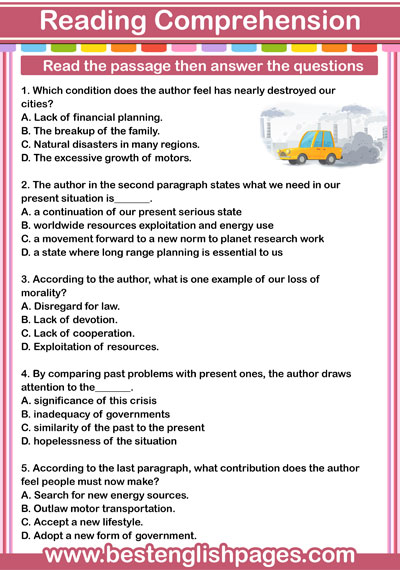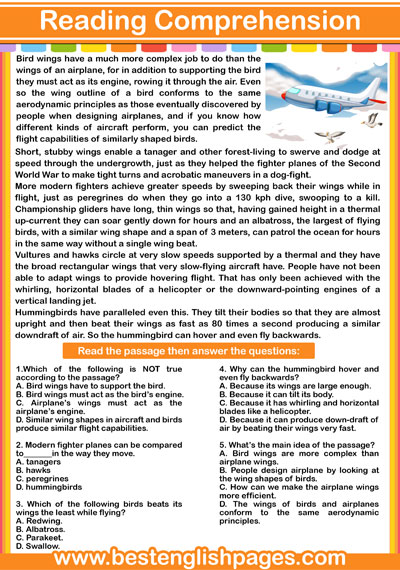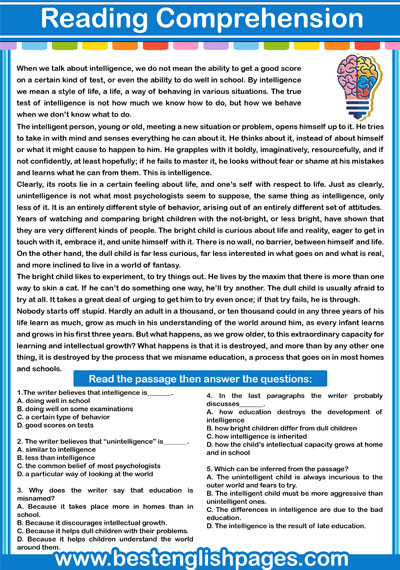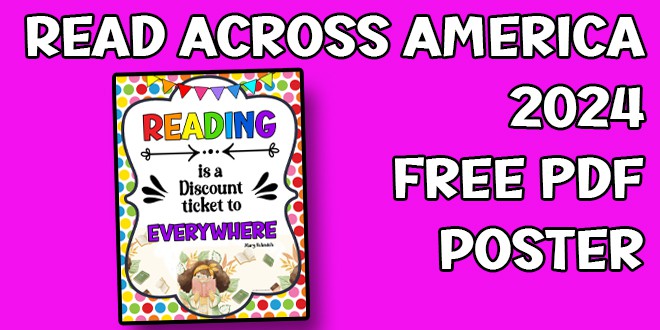You have reached this interesting post as you might be among those who have asked the following questions: what are some best short reading comprehension passages? printable reading comprehension worksheet? short passages with questions? reading comprehension worksheets pdf? reading comprehension worksheets adults? reading passages pdf? comprehension passage with questions and answers? reading comprehension passages with answers pdf? if so, then you have come to the right place.
In general, reading comprehension skills give English language learners and students the tools and opportunity to acquire new knowledge, through discrimination, visual perception, logical analysis, and recognition.
These comprehension worksheets will help boost students’ basic reading comprehension skills such as activating prior knowledge and expanding vocabulary knowledge as well.
This article compiles some good free ESL Printable reading comprehension worksheets pdf that will surely aid strengthen and sharpen the learners’ reading comprehension strategies. These ESL comprehension passages can be printed as worksheets and used for fluency practice, small group practice, whole group discussions, or homework.

Short Reading Comprehension Passages
ESL Reading Comprehension Exercise
The energy crisis, which is being felt around the world, has dramatized how the careless use of the earth’s resources has brought the whole world to the brink of disaster. The over-development of motor transport, with its increase of more cars, more highways, more pollution, more suburbs, more commuting, has contributed to the near destruction of our cities. The disaster has arrived in the form of energy crisis.
Our present situation is unlike war, revolution or depression. Worldwide resources exploitation and energy use have brought us to a state where long range planning is essential. What we need is not a continuation of our present serious state, which endangers the future of our country, our children, and our earth, but a movement forward to a new norm in order to work rapidly and effectively on planetary problems.
This country has been falling back under the continuing exposures of loss of morality and the revelation that lawbreaking has reached into the highest places in the land. There is a strong demand for moral revival and for some devotion that is vast enough and yet personal enough to enlist the devotion of all. In the past it has been only in a way in defense of their own country and their own ideals that any people have been able to devote themselves wholeheartedly.
This is the first time that we have been asked to defend ourselves and what we hold dear in cooperation with all the other inhabitants of this planet, who share with us the same endangered air and the same endangered oceans. There is a common need to reassess our present course, to change that course and to devise new methods through which the world can survive. This is a priceless opportunity.
To grasp it we need a widespread understanding of nature if the crisis confronting us—and the world—is a crisis that is no passing inconvenience, no by product of the ambitions of the oil producing countries, no environmentalists’ mere fears, no byproduct of any present system of government. What we face is the outcome of the invention of the last four hundred years. What we need is a transformed lifestyle. This new lifestyle can flow directly from science and technology, but its acceptance depends on a sincere devotion to finding a higher quality of life for the world’s children and future generation.
Read the passage then answer the questions:
- Which condition does the author feel has nearly destroyed our cities?
A. Lack of financial planning.
B. The breakup of the family.
C. Natural disasters in many regions.
D. The excessive growth of motors.
2. The author in the second paragraph states what we need in our present situation is_______.
A. a continuation of our present serious state
B. worldwide resources exploitation and energy use
C. a movement forward to a new norm to planet research work
D. a state where long range planning is essential to us
3. According to the author, what is one example of our loss of morality?
A. Disregard for law.
B. Lack of devotion.
C. Lack of cooperation.
D. Exploitation of resources.
4. By comparing past problems with present ones, the author draws attention to the_______.
A. significance of this crisis
B. inadequacy of governments
C. similarity of the past to the present
D. hopelessness of the situation
5. According to the last paragraph, what contribution does the author feel people must now make?
A. Search for new energy sources.
B. Outlaw motor transportation.
C. Accept a new lifestyle.
D. Adopt a new form of government.


English Printable Reading Comprehension Worksheet
Reading Comprehension for ESL Students
Bird wings have a much more complex job to do than the wings of an airplane, for in addition to supporting the bird they must act as its engine, rowing it through the air. Even so the wing outline of a bird conforms to the same aerodynamic principles as those eventually discovered by people when designing airplanes, and if you know how different kinds of aircraft perform, you can predict the flight capabilities of similarly shaped birds.
Short, stubby wings enable a tanager and other forest-living to swerve and dodge at speed through the undergrowth, just as they helped the fighter planes of the Second World War to make tight turns and acrobatic maneuvers in a dog-fight.
More modern fighters achieve greater speeds by sweeping back their wings while in flight, just as peregrines do when they go into a 130 kph dive, swooping to a kill. Championship gliders have long, thin wings so that, having gained height in a thermal up-current they can soar gently down for hours and an albatross, the largest of flying birds, with a similar wing shape and a span of 3 meters, can patrol the ocean for hours in the same way without a single wing beat.
Vultures and hawks circle at very slow speeds supported by a thermal and they have the broad rectangular wings that very slow-flying aircraft have. People have not been able to adapt wings to provide hovering flight. That has only been achieved with the whirling, horizontal blades of a helicopter or the downward-pointing engines of a vertical landing jet.
Hummingbirds have paralleled even this. They tilt their bodies so that they are almost upright and then beat their wings as fast as 80 times a second producing a similar downdraft of air. So the hummingbird can hover and even fly backwards.
Read the passage then answer the questions:
1.Which of the following is NOT true according to the passage?
A. Bird wings have to support the bird.
B. Bird wings must act as the bird’s engine.
C. Airplane’s wings must act as the airplane’s engine.
D. Similar wing shapes in aircraft and birds produce similar flight capabilities.
2. Modern fighter planes can be compared to_______in the way they move.
A. tanagers
B. hawks
C. peregrines
D. hummingbirds
3. Which of the following birds beats its wings the least while flying?
A. Redwing.
B. Albatross.
C. Parakeet.
D. Swallow.
4. Why can the hummingbird hover and even fly backwards?
A. Because its wings are large enough.
B. Because it can tilt its body.
C. Because it has whirling and horizontal blades like a helicopter.
D. Because it can produce down-draft of air by beating their wings very fast.
5. What’s the main idea of the passage?
A. Bird wings are more complex than airplane wings.
B. People design airplane by looking at the wing shapes of birds.
C. How can we make the airplane wings more efficient.
D. The wings of birds and airplanes conform to the same aerodynamic principles.


Short Passages with Questions
ESL Reading Comprehension Pdf
When we talk about intelligence, we do not mean the ability to get a good score on a certain kind of test, or even the ability to do well in school. By intelligence we mean a style of life, a life, a way of behaving in various situations. The true test of intelligence is not how much we know how to do, but how we behave when we don’t know what to do.
The intelligent person, young or old, meeting a new situation or problem, opens himself up to it. He tries to take in with mind and senses everything he can about it. He thinks about it, instead of about himself or what it might cause to happen to him. He grapples with it boldly, imaginatively, resourcefully, and if not confidently, at least hopefully; if he fails to master it, he looks without fear or shame at his mistakes and learns what he can from them. This is intelligence.
Clearly, its roots lie in a certain feeling about life, and one’s self with respect to life. Just as clearly, unintelligence is not what most psychologists seem to suppose, the same thing as intelligence, only less of it. It is an entirely different style of behavior, arising out of an entirely different set of attitudes.
Years of watching and comparing bright children with the not-bright, or less bright, have shown that they are very different kinds of people. The bright child is curious about life and reality, eager to get in touch with it, embrace it, and unite himself with it. There is no wall, no barrier, between himself and life. On the other hand, the dull child is far less curious, far less interested in what goes on and what is real, and more inclined to live in a world of fantasy.
The bright child likes to experiment, to try things out. He lives by the maxim that there is more than one way to skin a cat. If he can’t do something one way, he’ll try another. The dull child is usually afraid to try at all. It takes a great deal of urging to get him to try even once; if that try fails, he is through.
Nobody starts off stupid. Hardly an adult in a thousand, or ten thousand could in any three years of his life learn as much, grow as much in his understanding of the world around him, as every infant learns and grows in his first three years. But what happens, as we grow older, to this extraordinary capacity for learning and intellectual growth? What happens is that it is destroyed, and more than by any other one thing, it is destroyed by the process that we misname education, a process that goes on in most homes and schools.
Read the passage then answer the questions:
1.The writer believes that intelligence is_______.
A. doing well in school
B. doing well on some examinations
C. a certain type of behavior
D. good scores on tests
2. The writer believes that “unintelligence” is_______.
A. similar to intelligence
B. less than intelligence
C. the common belief of most psychologists
D. a particular way of looking at the world
3. Why does the writer say that education is misnamed?
A. Because it takes place more in homes than in school.
B. Because it discourages intellectual growth.
C. Because it helps dull children with their problems.
D. Because it helps children understand the world around them.
4. In the last paragraphs the writer probably discusses_______.
A. how education destroys the development of intelligence
B. how bright children differ from dull children
C. how intelligence is inherited
D. how the child’s intellectual capacity grows at home and in school
5. Which can be inferred from the passage?
A. The unintelligent child is always incurious to the outer world and fears to try.
B. The intelligent child must be more aggressive than unintelligent ones.
C. The differences in intelligence are due to the bad education.
D. The intelligence is the result of late education.






Leave a Reply